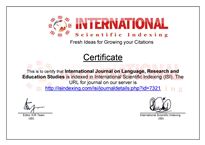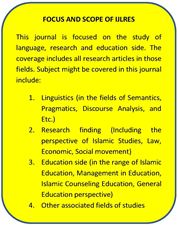THE EFFECT of SYNTAGMATIC AND PARADIGMATIC RELATIONSHIP ON LEARNING GRAMMAR AMONG IRANIAN PRE-INTERMEDIATE EFL LEARNERS
Abstract
The purpose of the present study was to explore the effects of using syntagmatic and paradigmatic relationships on learning grammar among Iranian pre-intermediate EFL learners. To fulfill the objectives of the study a Homogeneity test (Oxford Quick Placement Test) was administered among 70 students at the pre-intermediate level of a private language Institute and finally 40 participants were selected. Then, they were randomly divided into two subgroups, namely control and experimental groups. Before starting the treatment, a validated teacher-made grammar test was administered to students as pre-test to assess the participants' knowledge of grammar at the beginning of the course. Then, the experimental group received the treatment, which was teaching grammar through using syntagmatic and paradigmatic relations while the control group was taught using traditional methods of teaching. After 20 sessions of treatment,the two groups were administered the same teacher-made grammar test as post-test. Data were analyzed by Paired and Independent Samples t-test. The findings showed that the experimental group significantly performed better than the control group. Generally, the experimental groups outperformed the control groups. The results suggest that syntagmatic and paradigmatic relations can be used in English classes to develop listening grammar ability among Iranian EFL learners.
Full Text:
PDFReferences
Akbarov, H. L. (2016). Syntagmatic and paradigmatic features of relative syntagmas in Azerbaijani and English languages. European Scientific Journal (ESJ), 12(20), 214-231
Celce-Murcia, M. (1991) “language teaching approaches: an overview”. In Celce-Murcia,
M. (ed.) Teaching English as a second or foreign language PP. (114-117). Boston: Heinle & Heinle publishers.
Crystal, D. (2004). Rediscover grammar (3rd ed.). Harlow, Essex: Pearson Education.
De mauro, T. (2009). A che serve la grammatica?. In Fiorentino, G. (ed.) Perché la grammatica? (pp. 28-31), Roma: Carocci editore.
Gerot, L., & Wignell, P. (1994). Making sense of functional grammar. Sydney: Tanya Stabler.
Giunchi, P. (1990). Grammatica esplicita e grammatica implicita. In P. Giunchi (ed.), Grammatica esplicita e grammatica implicita. Bologna: Zanichelli.
Harris, R. (1987). Reading Saussure: A Critical Commentary on the 'Cours de linguistique générale'. London: Duckworth
Haruki, L (2006). The two principles of representation: paradigm and syntagm. Kansai University Institutional Library
Larsen-Freeman, D. (1991). Teaching grammar, in M. Celce-Murcia (ed.), Teaching English as a second language (pp. 279-283). Boston: Heinle & Heinle.
Leymore, L. V. (1975). Hidden Myth: Structure and Symbolism in Advertising. - New York: Basic Books.
Myhill, D. A., & Watson, A. (2014). The role of grammar in the writing curriculum: a review. Journal of Child Language Teaching and Therapy, 30(1), 41-62.
Pustejovsky, J. (2000). Syntagmatic Processes. In Handbook of Lexicology and Lexicography, de Gruyter.
Richards, J. C., & Renandya, W.A. (2002). Methodology in language teaching. Cambridge:
Cambridge University Press.
Richard, J. C., & Rodgers, T. (2001). Approaches and methods in language teaching. Cambridge: Cambridge University Press.
Saussure, F. (1974). Course in General Linguistics (trans. Wade Baskin). London: Fontana/Collins
Saussure, F (1983). Course in General Linguistics [1916] (trans. Roy Harris). London:Duckworth.
Seker, E. (2013). Paradigmatic, syntagmatic and contextual relations in Araby. Uluslararası Hakemli Sosyal Bilimler E-Dergisi. 1-21
Silverman, K. (1983). The Subject of Semiotics. New York: Oxford University Press
Soleimani, H., & Khandan, M. (2013).The effect of telling short stories on learning grammar among EFL high school students in Iran. International Journal of Language Learning and Applied Linguistics World, 4(2), 110-122
Silverman, D. & Brian, T. (1980): The Material Word: Some Theories of Language and its Limits. London: Routledge & Kegan Paul
Swan, M. (2005). What is grammar? In Beaven, B (ed.). IATEFL. Cardiff Conference Selections: 60-61.
Ur, P. (1991). A course in language teaching. Practice and theory. Cambridge: Cambridge University Press.
Ur, P. (1991). Grammar practice activities. A practical guide for teachers. Cambridge:
Cambridge University Press.
Weaver, C., McNally, C., & Moerman, S. (2001). To grammar or not to grammar: That is not the question! Voices from the Middle, 8(3). 17-33, Retrieved from
http://www.learner.org/workshops/middlewriting/images/pdf/W8ReadGrama.pdf
Refbacks
- There are currently no refbacks.
Copyright (c) 2018 INTERNATIONAL JOURNAL ON LANGUAGE, RESEARCH AND EDUCATION STUDIES

This work is licensed under a Creative Commons Attribution-NonCommercial-ShareAlike 4.0 International License.

IJLRES- International Journal on Language, Research and Education Studies published by English Language Center, Faculty of Islamic Education and Teacher Training, UIN of North Sumatra is licensed under a Creative Commons Attribution-NonCommercial-ShareAlike 4.0 International License. Based on work at: http://jurnal.uinsu.ac.id/index.php/ijlres
2580-6777 (Print ISSN), 2580-6785 (Online ISSN)




